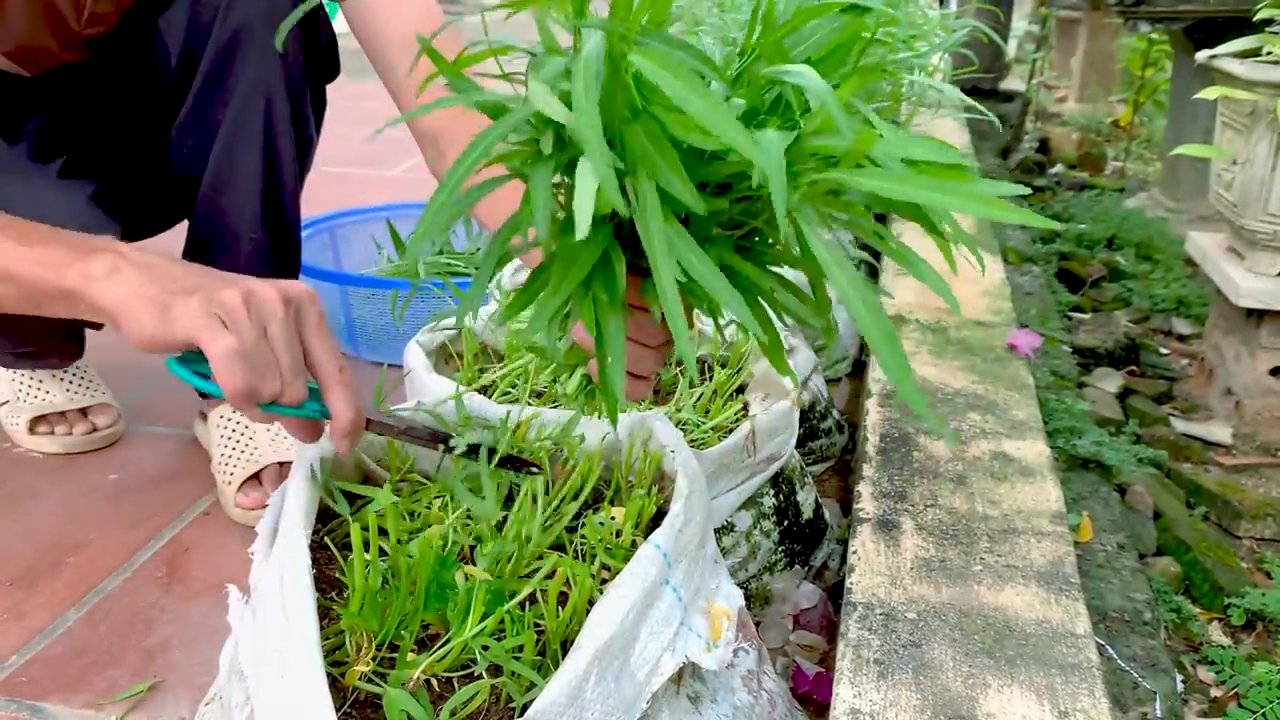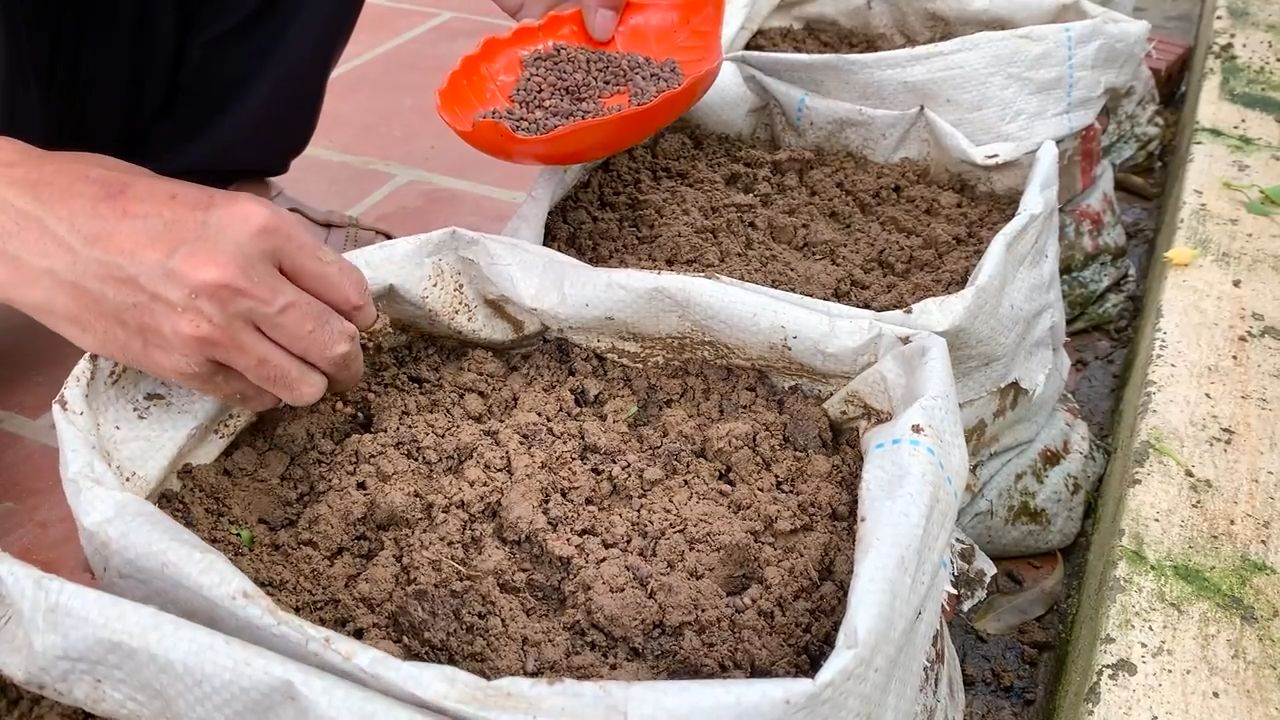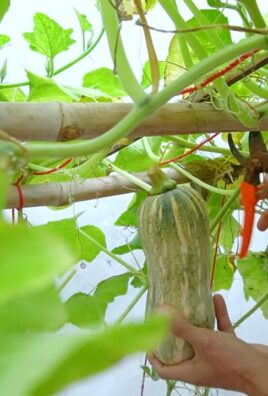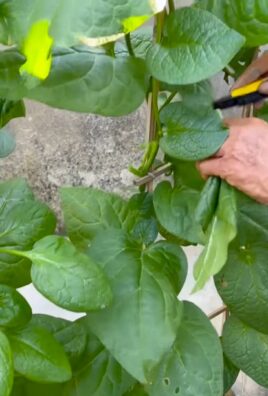Grow Water Spinach Fast and enjoy fresh, nutritious greens right from your backyard! Have you ever dreamed of harvesting your own vibrant, leafy vegetables just days after planting? Well, dream no more! This DIY guide unlocks the secrets to rapidly cultivating water spinach, also known as kangkong, a delicious and versatile ingredient in Asian cuisine.
Water spinach boasts a rich history, deeply rooted in Southeast Asian cultures where it has been a staple for centuries. From stir-fries to soups, its mild flavor and tender texture make it a culinary favorite. But beyond its taste, water spinach is packed with vitamins and minerals, making it a healthy addition to any diet.
Why should you learn this DIY trick? Because growing your own food is incredibly rewarding! Not only will you save money on groceries, but you’ll also have the satisfaction of knowing exactly where your food comes from. Plus, grow water spinach fast is surprisingly easy, even for beginner gardeners. This guide will walk you through simple steps and clever hacks to ensure a bountiful harvest in record time. Imagine the joy of serving a fresh, home-grown meal to your family, knowing you nurtured it from seed to table. Let’s get started and transform your garden into a thriving oasis of delicious, leafy greens!

Grow Your Own Water Spinach (Kangkong) Like a Pro!
Hey there, fellow gardening enthusiasts! Are you ready to dive into the wonderful world of water spinach, also known as Kangkong? This leafy green is not only delicious but also incredibly easy and fast to grow, making it a perfect choice for beginner gardeners and seasoned pros alike. I’m going to walk you through everything you need to know to cultivate your own thriving patch of Kangkong, right in your backyard (or even indoors!).
What You’ll Need: The Essential Supplies
Before we get our hands dirty, let’s gather all the necessary supplies. Trust me, having everything ready beforehand will make the whole process much smoother and more enjoyable.
* Water Spinach Seeds or Cuttings: You can find these at most garden centers or online. Seeds are generally easier to start with, but cuttings can give you a head start.
* A Container or Growing Area: This could be a large pot, a raised garden bed, or even a section of your backyard. The size will depend on how much Kangkong you want to grow.
* Soil: Water spinach thrives in rich, well-draining soil. A mix of potting soil, compost, and a little bit of sand works wonders.
* Water: As the name suggests, water spinach loves water! You’ll need a reliable water source to keep your plants happy.
* Fertilizer (Optional): While not strictly necessary, a balanced fertilizer can boost growth and yield.
* Sunlight: Water spinach needs at least 6 hours of sunlight per day.
* Gardening Gloves: To keep your hands clean and protected.
* Trowel or Small Shovel: For planting and transplanting.
* Watering Can or Hose: For watering your plants.
Getting Started: Planting Your Water Spinach
Now that we have our supplies, let’s get down to the nitty-gritty of planting. I’ll guide you through both seed starting and using cuttings, so you can choose the method that works best for you.
Starting from Seeds: A Step-by-Step Guide
1. Soaking the Seeds: To improve germination rates, soak your water spinach seeds in warm water for 12-24 hours before planting. This helps soften the seed coat and encourages sprouting. I usually put them in a small bowl and leave them overnight.
2. Preparing the Soil: Fill your chosen container or growing area with the soil mixture. Make sure the soil is loose and well-draining. I like to add a generous amount of compost to enrich the soil.
3. Sowing the Seeds: Sow the seeds about 1/2 inch deep and 1-2 inches apart. You can either sow them in rows or scatter them evenly across the surface.
4. Watering Gently: Water the soil gently after sowing, making sure not to dislodge the seeds. Keep the soil consistently moist but not waterlogged.
5. Providing Sunlight: Place the container in a sunny location that receives at least 6 hours of sunlight per day. If you’re growing indoors, you might need to supplement with grow lights.
6. Germination: Water spinach seeds typically germinate within 7-14 days. Be patient and keep the soil moist.
Starting from Cuttings: A Quick Start
1. Selecting Cuttings: Choose healthy, mature stems from an existing water spinach plant. The cuttings should be about 6-8 inches long and have several nodes (the points where leaves emerge).
2. Preparing the Cuttings: Remove the leaves from the bottom 2-3 inches of the cuttings. This will encourage root growth.
3. Rooting the Cuttings: You can root the cuttings in water or directly in soil.
* Rooting in Water: Place the cuttings in a glass or jar filled with water, making sure the bottom nodes are submerged. Change the water every 1-2 days. Roots should start to appear within a week or two.
* Rooting in Soil: Dip the cut ends of the cuttings in rooting hormone (optional) and plant them directly in the soil. Keep the soil moist and provide plenty of sunlight.
4. Planting the Rooted Cuttings: Once the cuttings have developed a good root system (if rooting in water), transplant them into your chosen container or growing area. Space them about 4-6 inches apart.
5. Watering and Sunlight: Water the newly transplanted cuttings thoroughly and place them in a sunny location.
Nurturing Your Water Spinach: Care and Maintenance
Now that your water spinach is planted, it’s time to provide the care and attention it needs to thrive. Here are some essential tips to keep your plants happy and productive.
1. Watering: Water spinach loves water, so keep the soil consistently moist. Water deeply whenever the top inch of soil feels dry. In hot weather, you may need to water daily.
2. Sunlight: Ensure your water spinach receives at least 6 hours of sunlight per day. If you’re growing indoors, use grow lights to supplement natural sunlight.
3. Fertilizing (Optional): To boost growth and yield, fertilize your water spinach every 2-3 weeks with a balanced fertilizer. Follow the instructions on the fertilizer package. I personally like using a liquid seaweed fertilizer.
4. Weeding: Keep your growing area free of weeds, as they can compete with your water spinach for nutrients and water.
5. Pest Control: Water spinach is generally pest-resistant, but occasionally aphids or spider mites may appear. If you notice any pests, treat them with insecticidal soap or neem oil.
6. Pruning: Regular pruning encourages bushier growth and prevents the plants from becoming leggy. Simply pinch off the tips of the stems to promote branching.
Harvesting Your Bounty: Enjoying Your Fresh Water Spinach
The best part of growing your own water spinach is, of course, the harvest! You can start harvesting your water spinach about 4-6 weeks after planting.
1. Harvesting Technique: Use scissors or a sharp knife to cut the stems about 6-8 inches from the top. This will encourage new growth from the remaining stems.
2. Harvesting Frequency: You can harvest your water spinach multiple times throughout the growing season. Just make sure to leave enough foliage for the plant to continue growing.
3. Storage: Freshly harvested water spinach can be stored in the refrigerator for up to a week. Wrap it in a damp paper towel and place it in a plastic bag.
Troubleshooting: Common Issues and Solutions
Even with the best care, you might encounter some challenges along the way. Here are some common issues and how to address them.
1. Yellowing Leaves: This could be a sign of overwatering, underwatering, or nutrient deficiency. Adjust your watering schedule and fertilize your plants if necessary.
2. Slow Growth: This could be due to insufficient sunlight, poor soil, or lack of fertilizer. Ensure your plants are getting enough sunlight, amend the soil with compost, and fertilize regularly.
3. Pest Infestation: Treat any pest infestations promptly with insecticidal soap or neem oil.
4. Disease: Water spinach is generally disease-resistant, but occasionally fungal diseases may occur. Ensure good air circulation and avoid overwatering to prevent fungal problems. If you notice any signs of disease, remove the affected leaves and treat the plants with a fungicide.
Advanced Tips and Tricks: Taking Your Kangkong Game to the Next Level
Want to become a true water spinach master? Here are some advanced tips and tricks to help you maximize your yield and enjoyment.
1. Succession Planting: To ensure a continuous harvest, sow new seeds or plant new cuttings every 2-3 weeks.
2. Growing in Water: Water spinach can also be grown directly in water, without soil. Simply place the cuttings in a container filled with water and provide plenty of sunlight. Change the water regularly to prevent algae growth.
3. Vertical Gardening: If you’re short on space, consider growing your water spinach vertically using a trellis or hanging baskets.
4. Companion Planting: Plant water spinach alongside other vegetables, such as tomatoes, peppers, and cucumbers, to create a mutually beneficial growing environment.
5. Saving Seeds: If you want to save seeds for future planting, allow some of your water spinach plants to flower and produce seeds. Collect the seeds when they are dry and brown.
Enjoying Your Harvest: Delicious Water Spinach Recipes
Now that you have a bountiful harvest of fresh water spinach, it’s time to enjoy the fruits (or rather, leaves) of your labor! Here are a few delicious recipes to get you started.
1. Stir-Fried Water Spinach with Garlic: This is a classic and simple dish that highlights the fresh flavor of water spinach. Simply stir-fry the water spinach with garlic,

Conclusion
So, there you have it! Growing water spinach fast, right in your own backyard (or even indoors!), is not only achievable but incredibly rewarding. Forget those expensive, often wilted bunches at the grocery store. With a little effort and this simple DIY trick, you can have a constant supply of fresh, crisp, and delicious water spinach at your fingertips.
This method isn’t just about convenience; it’s about control. You know exactly what’s going into your food – no harmful pesticides or questionable growing practices. You’re nurturing your own little ecosystem, contributing to a more sustainable lifestyle, and enjoying the unparalleled flavor of homegrown produce.
The rapid growth rate is a major selling point. Imagine planting your seeds or cuttings and, within weeks, harvesting your first batch of vibrant green leaves. This fast turnaround makes it perfect for impatient gardeners (like myself!) and those who want to see tangible results quickly.
But the beauty of this DIY approach lies in its adaptability. Feel free to experiment with different containers. While we’ve focused on tubs and buckets, you could try using raised garden beds lined with plastic or even repurposing old bathtubs for a more rustic look. The key is to ensure proper water retention.
Consider also experimenting with different nutrient solutions. While a balanced fertilizer works wonders, you can also explore organic options like compost tea or diluted fish emulsion. Observe your plants closely and adjust the nutrient levels accordingly. Remember, happy plants produce the best yields!
For those living in colder climates, don’t despair! Growing water spinach indoors is entirely possible. Just ensure your plants receive ample sunlight, either through a sunny window or with the help of grow lights. A little extra warmth can also help to accelerate growth.
And don’t be afraid to get creative with your water spinach recipes! It’s incredibly versatile and can be used in stir-fries, soups, salads, and even as a delicious side dish. Its mild, slightly nutty flavor pairs well with a variety of ingredients, from garlic and ginger to chili peppers and soy sauce.
We truly believe that this DIY trick for growing water spinach fast is a game-changer for home gardeners. It’s simple, effective, and incredibly satisfying. So, what are you waiting for? Grab your seeds or cuttings, prepare your container, and get ready to experience the joy of harvesting your own homegrown water spinach.
We’re confident that you’ll be amazed by the results. And once you’ve tried it, we’d love to hear about your experience! Share your photos, tips, and recipes in the comments below. Let’s build a community of water spinach enthusiasts and inspire others to embrace the joys of homegrown food. Happy gardening!
Frequently Asked Questions (FAQ)
What exactly is water spinach, and what does it taste like?
Water spinach (Ipomoea aquatica), also known as ong choy, morning glory, or swamp cabbage, is a semi-aquatic leafy green vegetable popular in Asian cuisine. It has long, hollow stems and arrow-shaped leaves. The taste is mild, slightly sweet, and subtly nutty, similar to spinach but with a more delicate texture. It’s incredibly versatile and readily absorbs flavors from sauces and seasonings.
How long does it really take to grow water spinach fast using this method?
While the exact timeframe can vary depending on factors like climate, sunlight, and nutrient levels, you can generally expect to harvest your first batch of water spinach within 4-6 weeks of planting seeds or cuttings. With optimal conditions, some gardeners have reported harvests in as little as 3 weeks. Regular harvesting encourages continued growth, so you can enjoy a continuous supply for several months.
What kind of container is best for growing water spinach?
The ideal container should be large enough to hold a significant amount of water and provide ample space for the roots to spread. A plastic tub, bucket, or even a large container lined with plastic works well. Aim for a container that is at least 12 inches deep and wide. Make sure it doesn’t have drainage holes, as water spinach thrives in a consistently moist environment. You can also use a kiddie pool for a larger crop.
What type of soil or growing medium should I use?
Water spinach isn’t particularly fussy about soil, but a well-draining, nutrient-rich potting mix is ideal. You can also use a mixture of garden soil, compost, and perlite or vermiculite to improve drainage. Some gardeners even grow water spinach hydroponically, without any soil at all, using a nutrient-rich water solution. The key is to provide the roots with adequate support and access to nutrients.
How much sunlight does water spinach need?
Water spinach thrives in full sun, requiring at least 6-8 hours of direct sunlight per day. If you’re growing it indoors, place it near a sunny window or supplement with grow lights. Insufficient sunlight can result in leggy growth and reduced yields.
How often should I water and fertilize my water spinach?
Water spinach needs to be kept consistently moist. The soil should always be damp to the touch. Check the water level regularly and add water as needed to maintain a consistent level. Fertilize every 2-3 weeks with a balanced liquid fertilizer, following the instructions on the label. Avoid over-fertilizing, as this can burn the roots.
How do I harvest water spinach?
Harvesting water spinach is easy! Simply cut the stems about 4-6 inches above the water level. This will encourage new growth from the cut stems, allowing you to harvest multiple times. You can harvest individual leaves or entire stems, depending on your preference.
Can I grow water spinach from cuttings?
Yes, growing water spinach from cuttings is a very effective method. Simply take cuttings from existing plants, about 6-8 inches long, and place them in water until roots develop. Once the roots are about an inch long, you can transplant them into your container.
Is water spinach safe to eat?
Yes, water spinach is generally safe to eat when grown in clean water and soil. However, it’s important to avoid growing it in areas with contaminated water, as it can absorb pollutants. Always wash the leaves thoroughly before eating.
Are there any pests or diseases that affect water spinach?
Water spinach is relatively pest-resistant, but it can occasionally be affected by aphids, spider mites, or whiteflies. These pests can be controlled with insecticidal soap or neem oil. Fungal diseases can also occur in humid conditions. Ensure good air circulation and avoid overwatering to prevent these problems.
Can I grow water spinach in cold climates?
Water spinach is a tropical plant and prefers warm temperatures. It can be grown in colder climates during the summer months, but it will likely need to be brought indoors when temperatures drop below 50°F (10°C). You can also grow it indoors year-round with the help of grow lights.
What are some delicious ways to cook with water spinach?
Water spinach is incredibly versatile and can be used in a variety of dishes. It’s commonly stir-fried with garlic, ginger, and chili peppers. It can also be added to soups, stews, and salads. Its mild flavor pairs well with a variety of sauces and seasonings, such as soy sauce, oyster sauce, and fish sauce. Try blanching it quickly and adding it to noodle dishes or using it as a topping for rice bowls. The possibilities are endless!




Leave a Comment